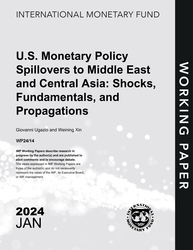
U.S. Monetary Policy Spillovers to Middle East and Central Asia: Shocks, Fundamentals, and Propagations
U.S. Monetary Policy Spillovers to Middle East and Central Asia: Shocks, Fundamentals, and Propagations
READ MORE...
Volume/Issue:
Volume 2024
Issue 014
Publication date: January 2024
ISBN: 9798400263101
$20.00
Add to Cart by clicking price of the language and format you'd like to purchase
Available Languages and Formats
| English |
Prices in red indicate formats that are not yet available but are forthcoming.
Topics covered in this book
This title contains information about the following subjects.
Click on a subject if you would like to see other titles with the same subjects.
Exports and Imports , Economics- Macroeconomics , Money and Monetary Policy , Economics / General , U , S , monetary policy , spillovers , fundamentals , oil prices , monetary policy shock , spillovers to Middle East , monetary policy spillover , information news shock , summary statistics table , Oil exports , Monetary tightening , Middle East and Central Asia , Global
Summary
We empirically examine U.S. monetary policy spillovers to the Middle East and Central Asia (ME & CA) region by decomposing U.S. interest rates changes into two orthogonal shocks: the pure monetary policy shock and the information news shock. Using a sample of 16 ME & CA countries, we find that when interest rates increase, the two shocks have opposite spillovers on the region. Tightening driven by contractionary monetary policy shocks hinders growth, while tightening driven by positive information news shocks boosts growth despite higher interest rates. Countries with weaker fundamentals face more negative spillovers from contractionary monetary policy shocks but may sometimes benefit more from positive information news shocks. Moreover, high oil prices mitigate both spillovers for oil exporters while global risk appetite amplifies both spillovers. Finally, we estimate a large degree of heterogeneity in the impact of the 2022 U.S. tightening cycle on ME & CA countries, with oil exporters with stronger fundamentals withstanding well the shock and oil importers with weaker fundamentals being hit the most.
Copyright © 2010 - 2025
Powered by:
AIDC



